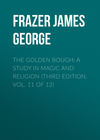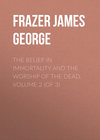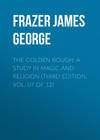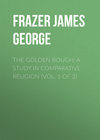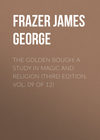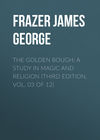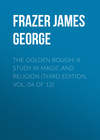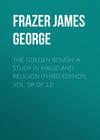Читать книгу: «The Golden Bough: A Study in Magic and Religion (Third Edition, Vol. 11 of 12)», страница 15
§ 4. A Suggested Theory of Totemism.586
Sex totems and clan totems may both be based on the notion that men and women keep their external souls in their totems, whether these are animals, plants, or what not.
But when a savage names himself after an animal, calls it his brother, and refuses to kill it, the animal is said to be his totem. Accordingly in the tribes of South-Eastern Australia which we have been considering the bat and the owl, the emu-wren and the superb warbler, may properly be described as totems of the sexes. But the assignation of a totem to a sex is comparatively rare, and has hitherto been discovered nowhere but in Australia. Far more commonly the totem is appropriated not to a sex, but to a clan, and is hereditary either in the male or female line. The relation of an individual to the clan totem does not differ in kind from his relation to the sex totem; he will not kill it, he speaks of it as his brother, and he calls himself by its name. Now if the relations are similar, the explanation which holds good of the one ought equally to hold good of the other. Therefore the reason why a clan revere a particular species of animals or plants (for the clan totem may be a plant) and call themselves after it, would seem to be a belief that the life of each individual of the clan is bound up with some one animal or plant of the species, and that his or her death would be the consequence of killing that particular animal, or destroying that particular plant. This explanation of totemism squares very well with Sir George Grey's definition of a totem or kobong in Western Australia. He says: “A certain mysterious connection exists between a family and its kobong, so that a member of the family will never kill an animal of the species to which his kobong belongs, should he find it asleep; indeed he always kills it reluctantly, and never without affording it a chance to escape. This arises from the family belief that some one individual of the species is their nearest friend, to kill whom would be a great crime, and to be carefully avoided. Similarly, a native who has a vegetable for his kobong may not gather it under certain circumstances, and at a particular period of the year.”587 Here it will be observed that though each man spares all the animals or plants of the species, they are not all equally precious to him; far from it, out of the whole species there is only one which is specially dear to him; but as he does not know which the dear one is, he is obliged to spare them all from fear of injuring the one. Again, this explanation of the clan totem harmonizes with the supposed effect of killing one of the totem species. “One day one of the blacks killed a crow. Three or four days afterwards a Boortwa (crow) [i. e. a man of the Crow clan] named Larry died. He had been ailing for some days, but the killing of his wingong [totem] hastened his death.”588 Here the killing of the crow caused the death of a man of the Crow clan, exactly as, in the case of the sex-totems, the killing of a bat causes the death of a Bat-man or the killing of an owl causes the death of an Owl-woman. Similarly, the killing of his nagual causes the death of a Central American Indian, the killing of his bush soul causes the death of a Calabar negro, the killing of his tamaniu causes the death of a Banks Islander, and the killing of the animal in which his life is stowed away causes the death of the giant or warlock in the fairy tale.
The savage may imagine his life to be bound up with that of more animals than one at the same time; for many savages think that every person has more souls than one.
Thus it appears that the story of “The giant who had no heart in his body” may perhaps furnish the key to the relation which is supposed to subsist between a man and his totem. The totem, on this theory, is simply the receptacle in which a man keeps his life, as Punchkin kept his life in a parrot, and Bidasari kept her soul in a golden fish. It is no valid objection to this view that when a savage has both a sex totem and a clan totem his life must be bound up with two different animals, the death of either of which would entail his own. If a man has more vital places than one in his body, why, the savage may think, should he not have more vital places than one outside it? Why, since he can put his life outside himself, should he not transfer one portion of it to one animal and another to another? The divisibility of life, or, to put it otherwise, the plurality of souls, is an idea suggested by many familiar facts, and has commended itself to philosophers like Plato,589 as well as to savages. It finds favour also with the sages of China, who tell us that every human being is provided with what may be called a male soul (shen) and a female soul (kwei), which by their harmonious co-operation compose an organic unity. However, some Chinese philosophers will have it that each of the five viscera has its own separate male soul (shen); and a Taoist treatise written about the end of the tenth or beginning of the eleventh century has even enriched science with a list of about three dozen souls distributed over the various parts of the human frame; indeed, not content with a bare catalogue of these souls, the learned author has annexed to the name and surname of each a brief description of its size and stature, of the kind of dress in which it is clothed and the shape of hat it wears.590 It is only when the notion of a soul, from being a quasi-scientific hypothesis, becomes a theological dogma that its unity and indivisibility are insisted upon as essential. The savage, unshackled by dogma, is free to explain the facts of life by the assumption of as many souls as he thinks necessary. Hence, for example, the Caribs supposed that there was one soul in the head, another in the heart, and other souls at all the places where an artery is felt pulsating.591 Some of the Hidatsa Indians explain the phenomena of gradual death, when the extremities appear dead first, by supposing that man has four souls, and that they quit the body, not simultaneously, but one after the other, dissolution being only complete when all four have departed.592 Some of the Dyaks of Borneo and the Malays of the Peninsula believe that every man has seven souls.593 The Alfoors of Poso in Celebes are of opinion that he has three.594 The natives of Laos suppose that the body is the seat of thirty spirits, which reside in the hands, the feet, the mouth, the eyes, and so on.595 Hence, from the primitive point of view, it is perfectly possible that a savage should have one soul in his sex totem and another in his clan totem. However, as I have observed, sex totems have been found nowhere but in Australia; so that as a rule the savage who practises totemism need not have more than one soul out of his body at a time.596
The Battas of Sumatra, who have totemism, believe that every person has a soul which is always outside of his body.
If this explanation of the totem as a receptacle in which a man keeps his soul or one of his souls is correct, we should expect to find some totemic people of whom it is expressly said that every man amongst them is believed to keep at least one soul permanently out of his body, and that the destruction of this external soul is supposed to entail the death of its owner. Such a people are the Battas of Sumatra. The Battas are divided into exogamous clans (margas) with descent in the male line; and each clan is forbidden to eat the flesh of a particular animal. One clan may not eat the tiger, another the ape, another the crocodile, another the dog, another the cat, another the dove, another the white buffalo, and another the locust. The reason given by members of a clan for abstaining from the flesh of the particular animal is either that they are descended from animals of that species, and that their souls after death may transmigrate into the animals, or that they or their forefathers have been under certain obligations to the creatures. Sometimes, but not always, the clan bears the name of the animal.597 Thus the Battas have totemism in full. But, further, each Batta believes that he has seven or, on a more moderate computation, three souls. One of these souls is always outside the body, but nevertheless whenever it dies, however far away it may be at the time, that same moment the man dies also.598 The writer who mentions this belief says nothing about the Batta totems; but on the analogy of the Australian, Central American, and African evidence we may conjecture that the external soul, whose death entails the death of the man, is housed in the totemic animal or plant.
If a totem is the receptacle in which a man keeps his external soul, it is no wonder that savages should conceal the secret from strangers.
Against this view it can hardly be thought to militate that the Batta does not in set terms affirm his external soul to be in his totem, but alleges other grounds for respecting the sacred animal or plant of his clan. For if a savage seriously believes that his life is bound up with an external object, it is in the last degree unlikely that he will let any stranger into the secret. In all that touches his inmost life and beliefs the savage is exceedingly suspicious and reserved; Europeans have resided among savages for years without discovering some of their capital articles of faith, and in the end the discovery has often been the result of accident.599 Above all, the savage lives in an intense and perpetual dread of assassination by sorcery; the most trifling relics of his person – the clippings of his hair and nails, his spittle, the remnants of his food, his very name600– all these may, he fancies, be turned by the sorcerer to his destruction, and he is therefore anxiously careful to conceal or destroy them. But if in matters such as these, which are but the outposts and outworks of his life, he is so shy and secretive, how close must be the concealment, how impenetrable the reserve in which he enshrouds the inner keep and citadel of his being! When the princess in the fairy tale asks the giant where he keeps his soul, he often gives false or evasive answers, and it is only after much coaxing and wheedling that the secret is at last wrung from him. In his jealous reticence the giant resembles the timid and furtive savage; but whereas the exigencies of the story demand that the giant should at last reveal his secret, no such obligation is laid on the savage; and no inducement that can be offered is likely to tempt him to imperil his soul by revealing its hiding-place to a stranger. It is therefore no matter for surprise that the central mystery of the savage's life should so long have remained a secret, and that we should be left to piece it together from scattered hints and fragments and from the recollections of it which linger in fairy tales.
§ 5. The Ritual of Death and Resurrection
This view of totemism may help to explain the rite of death and resurrection which forms part of many initiatory ceremonies among savages.
This view of totemism throws light on a class of religious rites of which no adequate explanation, so far as I am aware, has yet been offered. Amongst many savage tribes, especially such as are known to practise totemism, it is customary for lads at puberty to undergo certain initiatory rites, of which one of the commonest is a pretence of killing the lad and bringing him to life again. Such rites become intelligible if we suppose that their substance consists in extracting the youth's soul in order to transfer it to his totem. For the extraction of his soul would naturally be supposed to kill the youth or at least to throw him into a death-like trance, which the savage hardly distinguishes from death. His recovery would then be attributed either to the gradual recovery of his system from the violent shock which it had received, or, more probably, to the infusion into him of fresh life drawn from the totem. Thus the essence of these initiatory rites, so far as they consist in a simulation of death and resurrection, would be an exchange of life or souls between the man and his totem. The primitive belief in the possibility of such an exchange of souls comes clearly out in the story of the Basque hunter who affirmed that he had been killed by a bear, but that the bear had, after killing him, breathed its own soul into him, so that the bear's body was now dead, but he himself was a bear, being animated by the bear's soul.601 This revival of the dead hunter as a bear is exactly analogous to what, on the theory here suggested, is supposed to take place in the ceremony of killing a lad at puberty and bringing him to life again. The lad dies as a man and comes to life again as an animal; the animal's soul is now in him, and his human soul is in the animal. With good right, therefore, does he call himself a Bear or a Wolf, etc., according to his totem; and with good right does he treat the bears or the wolves, etc., as his brethren, since in these animals are lodged the souls of himself and his kindred.
The rite of death and resurrection among the Wonghi of New South Wales.
Examples of this supposed death and resurrection at initiation are as follows. In the Wonghi or Wonghibon tribe of New South Wales “the youths on approaching manhood attend a meeting of the tribe. The ceremonies of initiation are secret, and at them none but the men of the tribe who have been initiated attend with the novices. At the spot where the ceremonies are to be performed, a large oval space is cleared. The old men of the tribe conduct the ceremonies, and the ‘medicine man’ of the tribe is the master of them. Part of the proceedings consists in knocking out a tooth and giving a new designation to the novice, indicating the change from youth to manhood. When the tooth is knocked out, a loud humming noise is heard, which is made with an instrument of the following description: a flat piece of wood is made with serrated edges, and having a hole at one end, to which a string is attached, and this swung round produces a humming noise. The uninitiated are not even allowed to see this instrument. Women are forbidden to be present at these ceremonies, and should one, by accident or otherwise, witness them, the penalty is death. The penalty for revealing the secrets is probably the same. When everything is prepared the women and children are covered with boughs, and the men retire, with the young fellows who are to be initiated, to a little distance. It is said that the youths are sent away a short distance one by one, and that they are each met in turn by a Being, who, so far as I can understand, is believed to be something between a blackfellow and a spirit. This Being, called Thuremlin, it is said, takes the youth to a distance, kills him, and in some instances cuts him up, after which he restores him to life and knocks out a tooth. Their belief in the power of Thuremlin is undoubted.”602
Use of the bull-roarer at initiatory ceremonies in Australia. The sound of the bull-roarer compared to thunder. Belief of the Dieri that by sounding a bull-roarer a newly initiated young man produces a supply of edible snakes and lizards.
The foregoing account, while it applies strictly to one tribe only, may be regarded as typical of the initiation ceremonies performed on young men throughout the tribes of South-Eastern and Central Australia, except that among the Central tribes the practice of knocking out a tooth on these occasions is replaced by the equally mysterious and much severer bodily mutilations of circumcision and subincision, which are not practised by the tribes of the South-East.603 The instrument whose humming or booming sound accompanies the critical operation of knocking out the tooth of the novice, is the now well-known bull-roarer, which figures in many savage rites of initiation. Its true nature is concealed from the women and uninitiated lads, who are taught to believe that its sonorous and long-drawn notes are the voice of the mythical being, often called Daramulun, who lives in the sky, instituted the rites, and superintends their performance. The hollow roar of the slat of wood, as it is swung round and round, “represents the muttering of thunder, and the thunder is the voice of Daramulun, and therefore its sound is of the most sacred character. Umbara once said to me, ‘Thunder is the voice of him (pointing upward to the sky) calling on the rain to fall and make everything grow up new.’ ”604 This supposed resemblance of the sound to thunder probably explains a certain use which the Dieri, a tribe of Central Australia, made of the instrument. When a young man had passed through an initiatory rite, which consisted in cutting a row of gashes in his back, he was given a bull-roarer, and when he went out in search of game, he used to twirl the implement in the belief that by doing so, while his wounds were still unhealed, he created a good harvest of snakes, lizards, and other reptiles, which the natives employ as food; but on the contrary they imagined that these supplies of food would be cut off for ever, if a woman were to see a bull-roarer which had been swung at the rites of initiation.605 No doubt these savages, living in a parched wilderness where the existence of plants and animals depends on rare and irregular showers,606 have observed that the fall of rain is regularly followed by a great and sudden increase in the food supply, and that this increase is most marked after violent thunder-storms. Hence by making a noise like thunder with the help of bull-roarers they probably hope, on the principle of imitative magic, to bring on a thunder-storm and with it a fertilizing deluge of rain.
The bull-roarer used by the Indians of New Mexico and Arizona to procure rain. The bull-roarer used in Torres Straits Islands to produce wind and good crops.
For the same reason in the parched and torrid regions of Arizona and New Mexico the Indians make great use of the bull-roarer in their ceremonies for procuring rain. For example, when Captain Bourke was at the Pueblo Indian village of Walpi in the month of August, 1881, he saw the instrument in use at the snake dance. “The medicine-men twirled it rapidly, and with a uniform motion, about the head and from front to rear, and succeeded in faithfully imitating the sound of a gust of rain-laden wind. As explained to me by one of the medicine-men, by making this sound they compelled the wind and rain to come to the aid of the crops. At a later date I found it in use among the Apache, and for the same purpose.”607 The Zuñi Indians of New Mexico whirl bull-roarers “to create enthusiasm” among the mythical beings who are supposed to cause rain, or for the purpose of making them gather in the air over the village.608 In a Zuñi rain-making ceremony, while one medicine-man whirls a bull-roarer, another whips up a mixture of water and meal into frothy suds symbolic of clouds, and a third plays a flute. “All this is an invocation to the gods for rain – the one great and perpetual prayer of the people of this arid land.”609 This supposed connexion of the instrument with thunder-storms explains why the Navajos of the same torrid country say that the bull-roarer should always be made of wood from a pine-tree that has been struck by lightning;610 and why the Bakairi of Brazil call the unpretentious instrument by a name that means “thunder and lightning.”611 The resemblance of the sound of the bull-roarer to the roaring of the wind is doubtless the reason why in the Torres Straits Islands wizards whirled bull-roarers in order to make the wind to blow,612 and why, when Caffres wish for calm weather, they forbid boys to play with bull-roarers, because they think that the booming noise attracts a gale of wind.613 Hence, as an instrument whose sound resembles the rumbling of thunder, the roar of wind, and the patter of rain, the bull-roarer is naturally swung by agricultural savages as a powerful means of promoting the growth of the crops. In the island of Kiwai, off the mouth of the Fly River in British New Guinea, bull-roarers are whirled in order to ensure a good crop of yams, sweet potatoes, and bananas.614 Similarly the Yabim of German New Guinea imagine that by twirling bull-roarers while they mention the names of the dead they produce a fine crop of taro.615
The whirling of bull-roarers by young men with bleeding backs in Australia seems to have been a rain-making ceremony.
But why among the Dieri of Central Australia should the power of attracting rain and so ensuring a supply of food be specially attributed to a young man whose back has just been scored and whose wounds are still raw? Perhaps the reason may be that the blood dripping from the gashes is thought to resemble rain and therefore to be endowed with a magical potency of drawing showers from the clouds. The conjecture is confirmed by the observation that the Dieri actually do bleed themselves avowedly for the purpose of making rain, and they are not the only people in Australia and elsewhere who have resorted to this singular mode of putting an end to a drought.616 Altogether the foregoing evidence seems to hint that the whole virtue of the bull-roarer resides, as its English name implies, in its voice, and that its original significance was simply that of a magical instrument for causing thunder, wind, and rain.617 When these natural phenomena came to be personified as spirits, the sound of the bull-roarer was naturally interpreted as their voice.
The sound of the bull-roarer at initiation is believed by Australian women and children to be the voice of a spirit, who carries away the novices.
Among the tribes on the Brisbane River in Queensland the weird sound of the bull-roarers swung at initiation was believed by the women and children to be made by the wizards in swallowing the boys and bringing them up again as young men. The Ualaroi of the Upper Darling River said that the boy met a ghost, who killed him and brought him to life again as a young man. Among the natives on the Lower Lachlan and Murray Rivers it was Thrumalun (Daramulun) who was thought to slay and resuscitate the novices.618 In the Arunta tribe of Central Australia, at the moment when the lads are being circumcised, the bull-roarer sounds in the darkness all round the ceremonial ground; and the awestruck women, listening in the distance, believe that it is the voice of a spirit called Twanyirika, who lives in wild and inaccessible regions and only comes out when a youth is initiated. They think that the spirit enters the body of the lad after the operation of circumcision has been performed and carries him away into the bush, keeping him there till his wound is healed. While the newly circumcised youth is out in the wilds, carefully secluded from the sight of the women and children, he constantly sounds the bull-roarer. When he has recovered from the wound, the spirit leaves him and he returns to camp an initiated, or rather partially initiated, man. He has learned, at all events, the secret of Twanyirika; for no sooner is he circumcised than an elder brother comes up to him, and placing in his hands a bundle of sacred sticks or stones (churinga), says, “Here is Twanyirika, of whom you have heard so much. They are churinga and will help you to heal quickly; guard them well, or else you and your mothers and sisters will be killed.”619
In some Australian tribes the women believe that lads at initiation are killed and brought to life again by a spirit, whose voice is heard in the sound of the bull-roarer.
In this account nothing is said about killing the lad and bringing him to life again; but a belief in the death and resurrection of the novices at initiation is expressly affirmed to be part of the feminine creed in other tribes of Central Australia. Thus in the Unmatjera tribe both women and children believe that Twanyirika kills the youth and afterwards brings him to life again during the period of initiation. The rites of initiation in this tribe, as in the other Central tribes, comprise the operations of circumcision and subincision; and as soon as the second of these has been performed on him, the young man receives from his father a sacred stick (churinga), with which, he is told, his spirit was associated in the remotest past. While he is out in the bush recovering from his wounds, he must swing the bull-roarer, or a being who lives up in the sky will swoop down and carry him off.620 In the Urabunna tribe of Central Australia a lad at initiation receives a bull-roarer, the very name of which (chimbaliri) is never heard by women and children. They are taught to believe that the sound of it is the voice of a spirit called Witurna, who takes the boy away, cuts out all his bowels, provides him with a new set, and brings him back an initiated youth. The lad is warned that on no account may he allow a woman or a child to see the sacred stick, else he and his mother and sisters will fall down as dead as stones.621 In the Binbinga tribe, on the western coast of the Gulf of Carpentaria, the women and children believe that the noise of the bull-roarer at initiation is made by a spirit named Katajalina, who lives in an ant-hill and comes out and eats up the boy, afterwards restoring him to life.622 Similarly among their neighbours the Anula the women imagine that the droning sound of the bull-roarer is produced by a spirit called Gnabaia, who swallows the lads at initiation and afterwards disgorges them in the form of initiated men. In this tribe, after a lad has been subincised as well as circumcised, he is presented with a bull-roarer and informed that the instrument was originally made by the whirlwind, that it is sacred or tabooed, and that it may on no account be shewn to women or children.623
A drama of resurrection from the dead used to be shewn to novices at initiation in some tribes of New South Wales. Dr. Howitt's description of the scene. The seeming dead man in the grave. The resurrection from the grave.
Among the tribes settled on the southern coast of New South Wales, of which the Coast Murring tribe may be regarded as typical, the drama of resurrection from the dead was exhibited in a graphic form to the novices at initiation. Before they were privileged to witness this edifying spectacle they had been raised to the dignity of manhood by an old man, who promoted them to their new status by the simple process of knocking a tooth out of the mouth of each with the help of a wooden chisel and hammer. The ceremony of the resurrection has been described for us in detail by an eye-witness, the late Dr. A. W. Howitt, one of the best authorities on the customs of the Australian aborigines. The scene selected for the sacred drama was the bottom of a deep valley, where a sluggish stream wound through a bed of tall sharp-edged sedge. Though the hour was between ten and eleven o'clock in the morning, the sun had but just peeped over the mountains which enclosed the valley like a wall on the east; and while the upper slopes, clothed with a forest of tall rowan trees, looked warm and bright in sunshine, which shot between the grey stems and under the light feathery foliage of the trees, all the bottom of the dell was still in deep shadow and dank with the moisture of the night's rain. While the novices rested and warmed themselves at a crackling fire, the initiated men laid their heads together, prepared a stock of decorations made of stringy bark, and dug a grave. There was some discussion as to the shape of the grave, but the man who was to be buried in it decided the question by declaring that he would be laid in it on his back at full length. He was a man of the eagle-hawk totem and belonged to the tribal subdivision called Yibai. So while two men under his directions were digging the grave with sticks in the friable granitic soil, he superintended the costume of the other actors in the drama. Sheets of bark were beaten out into fleeces of stringy fibre, and in these garments six performers were clothed from head to foot so that not even a glimpse could be obtained of their faces. Four of them were tied together by a cord which was fastened to the back of their heads, and each of them carried two pieces of bark in his hands. The other two walked free, but hobbled along bent double and supporting their tottery steps on staves to mark the weight of years; for they played the part of two medicine-men of venerable age and great magical power. By this time the grave was ready, and the eagle-hawk man stretched himself in it at full length on a bed of leaves, his head resting on a rolled-up blanket, just as if he were a corpse. In his two hands, crossed on his chest, he held the stem of a young tree (Persoonia linearis), which had been pulled up by the roots and now stood planted on his chest, so that the top of it rose several feet above the level of the ground. A light covering of dried sticks filled the grave, and dead leaves, tufts of grass, and small plants were artistically arranged over them so as to complete the illusion. All being now ready, the novices were led by their sisters' husbands to the grave and placed in a row beside it, while a singer, perched on the trunk of a fallen tree at the head of the grave, crooned a melancholy ditty, the song of Yibai. Though the words of the song consisted merely of a monotonous repetition of the words Burrin-burrin Yibai, that is, Stringy-bark Yibai, they were understood to refer to the eagle-hawk totem, as well as to the tribal subdivision of the buried man. Then to the slow, plaintive but well-marked air of the song the actors began to move forward, winding among the trees, logs, and rocks. On came the four disguised men, stepping in time to the music, swaying from side to side, and clashing their bark clappers together at every step, while beside them hobbled the two old men keeping a little aloof to mark their superior dignity. They represented a party of medicine-men, guided by two reverend seniors, who had come on pilgrimage to the grave of a brother medicine-man, him of the eagle-hawk totem, who lay buried here in the lonely valley, now illumined by the warm rays of the sun; for by this time the morning was wearing on to noon. When the little procession, chanting an invocation to Daramulun, had defiled from among the rocks and trees into the open, it drew up on the side of the grave opposite to the novices, the two old men taking up a position in the rear of the dancers. For some time the dance and song went on till the tree that seemed to grow from the grave began to quiver. “Look there!” cried the sisters' husbands to the novices, pointing to the trembling leaves. As they looked, the tree quivered more and more, then was violently agitated and fell to the ground, while amid the excited dancing of the dancers and the chanting of the tuneful choir the supposed dead man spurned from him the superincumbent mass of sticks and leaves, and springing to his feet danced his magic dance in the grave itself, and exhibited in his mouth the magic substances which he was supposed to have received from Daramulun in person.624
Покупайте книги и получайте бонусы в Литрес, Читай-городе и Буквоеде.
Участвовать в бонусной программе
